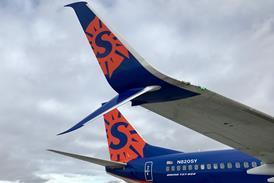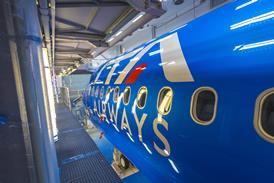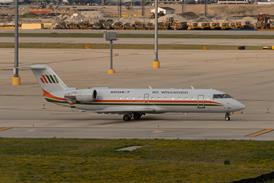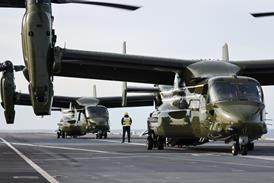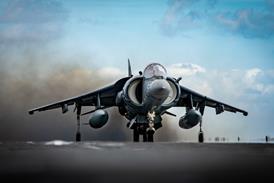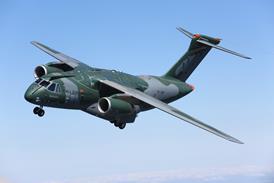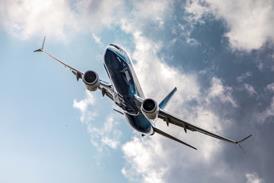GRAHAM WARWICK / WASHINGTON DC
A hundred years ago, the Wright brothers created the discipline of aeronautical engineering and achieved powered flight. Now their methods are being recreated
Recreating the aircraft of the Wright brothers has become a cottage industry in the run-up to the centenary of flight. The task of replication is not as easy as it seems, because surprisingly little information survives on the Wrights' early designs, including the aircraft that, on 17 December 1903, became the first powered, heavier-than-air machine to achieve controlled, sustained flight with a pilot aboard.
The 1903 Wright Flyer is a favourite subject for reproduction, but its notoriously difficult handling means that no exact replica has yet been flown successfully. That should change in this 100th year of aviation. The US Centennial of Flight Commission says at least nine flyable 1903 Flyer replicas should make their debuts this year - and that is just in the USA. Similar projects are under way as far afield as Australia.
The American Institute of Aeronautics and Astronautics (AIAA), for one, is building a flyable aircraft based on the static replica now touring the USA. The static replica was the first 1903 Wright Flyer to be windtunnel tested, in NASA Ames Research Center's 12 x 24m (40 x 80ft) low-speed tunnel in 1999. Modifications resulting from windtunnel tests will be incorporated in the second flying replica to make it more flyable.
Meanwhile, Utah State University (USU) has built a replica of the 1903 Flyer using modern composite materials, as if the Wrights had built it today. Made of carbonfibre, glassfibre and Kevlar composites and the wings covered with Dacron fabric, the USU's Wright Flyer is about half the weight of the original. Flight-testing of the "space-age" flyer is imminent.
Recreating the most historic of all aircraft is a challenge in itself, but others have set out to reproduce the Wrights' entire body of work. Because their early aircraft were destroyed along with all construction drawings, and because the Wrights became increasingly secretive, no complete historical record of their efforts exists. While the 1903 Flyer survives, and hangs in the Smithsonian's National Air and Space Museum in Washington DC, little remains of the Wrights' other developmental aircraft except some artifacts, letters and an invaluable collection of photographs.
"It's the greatest detective story never told," says Ken Hyde, head of the Wright Experience, a Virginia-based team that is researching, reconstructing and testing authentic reproductions of the Wrights' developmental aircraft and engines. "By walking in their footsteps, we are trying to discover how the Wrights were able to do what they did in four short years. They left a good paper trail, but were quite secretive."
No blueprints
The walk began in 1992 when Hyde, an aircraft restorer, was commissioned to reproduce a Wright B Flyer for the US Army Aviation Museum at Fort Rucker, Alabama. "We thought it would take 18 months, but six months went by just on research," he says. "Material was hard to come by. There were no blueprints or drawings, so we had to pull the information out of papers and letters. In the end, we copied everything we could get our hands on."
The B Flyer replica was built, along with a second aircraft for the College Part Aviation Museum in Maryland. Then, in 1998, the group began to look ahead to the 100th anniversary of flight. "We decided to build a series of aircraft, starting with the kites and gliders," says Hyde. A reproduction of the Wrights' 1899 Kite - the first aircraft to use wing warping for lateral control - was flown at Kitty Hawk, North Carolina, in 1997. Replicas of the 1900 Kite/Glider and 1901 Glider were flight-tested the same year, and the results matched those of the Wrights.
It was the disappointing performance of the 1901 Glider that led the Wrights to question the data used for their designs, and resulted in the first use of a windtunnel for aerodynamic research. This period is seen as the birth of aeronautical engineering and resulted in the 1902 Glider, the first fully controllable aircraft ever built and the basis for the 1903 Flyer.
After completing their landmark tests in December 1901, the Wrights never again used the windtunnel, nor did they preserve it, leaving the Wright Experience with the challenge of recreating the instrument from descriptions. It was the same with the Wrights' early aircraft: once they had fulfilled their purpose, they were discarded.
After 1901, the Wrights sought to hide their technical breakthroughs from imitators, destroying the construction documentation and drawings. "It was not their nature originally to be secretive," says Hyde. "After the windtunnel test, it changed."
Having completed and flown a reproduction 1902 Glider early in 2002, the Wright Experience began work on the 1903 Flyer. The team plans to build three flyable replicas. One is sponsored by the Experimental Aircraft Association and has been selected by the US National Park Service for the first-flight re-enactment planned for 17 December at Kill Devil Hills, North Carolina. The second is to be donated by former Learjet chairman Harry Combs for permanent display at the Wright National Memorial in Kitty Hawk. A sponsor is being sought for the third machine.
Surprisingly, the 1903 Flyer was only the starting point for the reproduction task, because it has been through several restorations and is no longer truly original. Overturned and damaged by a gust at Kitty Hawk, the 1903 Flyer was, unlike most Wright prototypes, salvaged and stored, but virtually forgotten until 1916, when it was repaired and reassembled by Orville Wright.
The Flyer was extensively refurbished before being loaned to London's Science Museum in 1928. Orville Wright sent the aircraft out of the USA in protest at the Smithsonian Institute's claim that Samuel Langley's Grand Aerodrome of 1903 was the first machine "capable" of powered flight. The Smithsonian eventually recognised the Wrights' claim to be first and the Flyer was repatriated in 1948. In 1985, the National Air and Space Museum undertook a major refurbishment of the aircraft.
"The original Flyer is far away from the aircraft now in the museum," says Hyde. Engine, propellers and fabric are among the items replaced. "When the museum did its preservation work in 1985, it produced good drawings and photographed every part of the aircraft. But when you look at the photographs from 1903, they don't match up. If you build an aircraft to the 1985 blueprints, it does not fly. We've had to dig a lot deeper."
Digital imaging
The Wright Experience has used digital imaging to extract data from the Wrights' photographs. "We spend 20 hours on research for every hour we spend on the aircraft to verify the shape of a part," says Hyde. The Wright family has provided the team with artifacts, including a section of fabric from the 1903 Flyer. The Pride of the West muslin, used for women's underwear and no longer produced, played an important part in its aerodynamic and structural characteristics.
The team is also recreating the Wrights' methodical and incremental work on engines and propellers. Horizontal Four engines are being built for the reproduction Flyers based on a study of the surviving test engine donated by Orville Wright to the Dayton Engineers' Club. The wooden propellers have been carved using period tools, based on analysis of a surviving fragment of the 1903 propeller. Hyde says the path to an authentic, flyable 1903 Flyer reproduction is almost clear. "We have the fabric and the engine, we are working on instrumentation, and there are the things that drive us nuts, like the fuel hose. We're in pretty good shape, but it takes some digging."
Testing of the reproduction Flyer in NASA's full-scale windtunnel is planned for February, and the Wright Experience hopes to flight test at Kitty Hawk in March. The 1902 Glider reproduction is being used for pilot training. Four pilots have logged 45min flying over 67 flights. Data from windtunnel testing of the 1902 Glider and 1903 Flyer will be used in a simulator.
The Kitty Hawk flight tests will be filmed in case weather prevents a restaging of the Wrights' first flight on 17 December. "We will not exceed the parameters of the 1903 flight," says Hyde. The second Flyer reproduction will be completed by October, but will be used for static display only until after the first-flight re-enactment. The same goes for the third machine, if the Wright Experience can find a sponsor.
The team is already looking ahead to the Wrights' next machine, the 1904 Huffman Prairie Flyer, but again has to find a sponsor. This aircraft was the first to fly in a complete circle, but is seen as an interim step toward the 1905 Dayton Flyer, regarded as the world's first practical aircraft. "The Wrights made a number of mistakes [in 1904], trying to improve the machine," says Hyde. "The 1905 machine was the turning point. The 1905 Flyer completed flights of over 40 miles [64km], and is one of a handful of surviving Wright aircraft.
"The real discoveries came after 1903. The 1905 Flyer was the first practical aircraft, but there was a big struggle in 1904-5 to get to that point. The first public flights in 1908 were the real culmination."
The Wright Experience is also building a flyable 1911 Wright B Flyer for a TV documentary, using the surviving Vertical Four engine, serial number 20, the only original operating Wright engine in the world.
The painstaking work of the Wright Experience, which has been described as "aeronautical archaeology", is far from over. "We will not solve all the questions, but we are going to leave a pretty good legacy," says Hyde, who believes reverse engineering has provided a vital insight into the Wrights' methods. "You could not go through the windtunnel testing and come out believing the 'lucky bicycle mechanics' theory."
Source: Flight International

